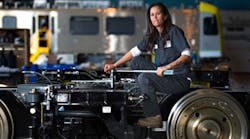Factory Skills Gap Could Spell Trouble for Trump’s Jobs Plan
Now that Donald Trump has added president to his resume, he’s eyeing another title: job creator-in-chief.
His goal is 25 million new positions, boosted by the factories he plans to bring back to U.S. shores. Yet he’ll be working against a powerful headwind, because company leaders are already struggling to find Americans to fill manufacturing openings.
On the bright side, Trump inherits a healthy jobs market, with ADP Research Institute data showing that January hiring was the fastest in seven months. Economists expect Friday’s official nonfarm payroll numbers to confirm that U.S. employers hired at a brisk 175,000-a-month pace.
But according to research from human resources consultancy Randstad Sourceright, unmet demand for talent clouds the otherwise rosy outlook. The firm surveyed more than 400 U.S. executives and found that companies expect to hire extensively in the coming year to address anticipated growth — 41% will add workers, compared to 32% who did so last year. But an even greater number see the skills gap impacting their businesses in the future.
Four-fifths of executives surveyed said that a shortage of sufficiently skilled workers will affect their companies in the next 12 months. The most-represented sector in the survey is manufacturing, which the Trump White House calls the “backbone of our economy.” Complaints of hard-to-fill factory jobs are backed up by Bureau of Labor Statistics data: 324,000 manufacturing spots were open in November, up from 238,000 a year earlier.
“Talent scarcity is a direct result of having a fully-employed workforce, especially in IT-type and other professional-skill jobs,” Randstad Sourceright CEO Rebecca Henderson said, explaining that companies are using immigrants and overseas workers to supplement their workforce. ”You fill those gaps using workers that are willing to come to the U.S. and with the right skill set and education, but the other trend you see is to get that work done offshore.”
While the tech sector is offshoring to plug the skills gap, U.S. manufacturers have relied even more heavily on another trend: automation, which helps them to compete with lower-cost foreign labor markets. Large employers are also using contingent workers, who work on-demand, as a way to stay nimble. One-third of companies predicted that 30% of their workforce will be flexible in the next year.
The big question now is whether Trump’s policies can overcome that underlying skills gap to create good, lasting work for Americans, or whether new jobs during his tenure will continue to follow the gig economy and automation trends.
By Andre Tartar




